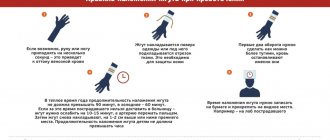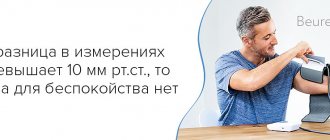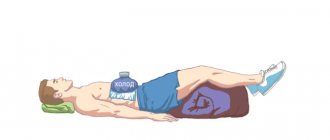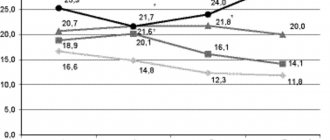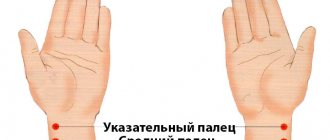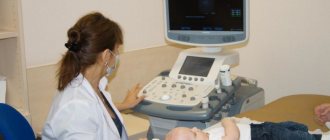If you find yourself in a situation where you don’t have a tonometer at hand, and your condition is gradually worsening, your own body will help you find out the indicators. Few people know how to determine blood pressure from the pulse, but knowledge in this matter can save lives in an extreme situation.
What is pressure?
Pressure represents the amount of blood supply and movement through the vessels. Depending on the health of body functions, pressure may vary. The indicator is considered individual, but the approximate norm is 120 to 80.
Blood pressure depends on the amount of fluid moving through the vessels. In this regard, there are factors that can influence the excess of this indicator.
An increase in the amount of fluid occurs for the following reasons:
- Retention of excess moisture in the body occurs due to excessive salt consumption. For example, drinking a large amount of beer together with a salty snack in the morning will provoke swelling of the face, and the excessive load on the blood vessels will remain an invisible problem. You should avoid eating sausages, canned food, and smoked foods.
- Atherosclerosis is also a cause of fluid retention, since the disease refers to blockage of blood vessels, their slagging. Avoiding trouble will help you avoid fatty foods and follow a diet based on proper nutrition.
- Hormonal imbalance is also one of the reasons for the insufficient functioning of blood vessels and the retention of excess in the body. At the same time, there is a decrease in the speed of all existing processes in the body.
- Overeating and increased water consumption affect the amount of fluid moving through the vessels.
- Bad habits: smoking and alcohol affect the health of blood vessels, gradually narrowing the lumen. This reduces the quality of blood circulation in the body.
How can you help?
The treatment regimen is presented in the table.
Table 6. How is treatment carried out?
| Reason for violation | How to fix it? |
| Elimination of fluid deficiency in the body. |
| Stop bleeding, replenish the volume of circulating blood. Intravenous administration of medicinal solutions is prescribed. |
| Use of electrical cardioversion. |
| Detoxification of the body, introduction of antidotes. In more complex cases, hemodialysis is prescribed. The blood is cleansed of poisons using an artificial kidney apparatus. |
| Dosage adjustment or discontinuation of the provoking medication. |
| Anemia. | Increasing the level of red blood cells and hemoglobin in the blood. The patient is prescribed the use of iron supplements. In difficult cases, the doctor resorts to donor blood transfusion. |
| Valve replacement surgery. |
Pressure norm
Pressure is an individual indicator, which depends on environmental conditions, age, the presence of problems in the body, and even the time of day. There is a medical norm, in relation to which the doctor assumes any changes in the patient’s body.
Normal pressure is pressure that was measured according to rules that assume that the person was at rest and was not physically and emotionally stressed. High blood pressure is considered to be that which has risen above 140 to 90. It already indicates the presence of a serious malfunction in the body
As you grow older, irreversible changes occur in your body, causing your normal blood pressure levels to increase. This is associated with some loss of health of certain organs, including blood vessels and the heart. A deviation from the norm is not only high, but also low blood pressure. A decrease may relate to disorders of the cardiovascular system, an increase may relate to heart pathologies.
Regular measurement of blood pressure and pulse can help avoid serious consequences, since changes will be visible at the initial stage.
Features of drug therapy
Groups of drugs that are prescribed to normalize heart rate and blood pressure are presented in the table.
Table 7. What medications are prescribed?
| Group of drugs | Description |
| They help reduce the intensity of contraction of the ventricular muscles, reduce the permeability of cells to calcium ions. |
| Accompany a decrease in the permeability of cell membranes to sodium and calcium. The principle of action is similar to that of calcium channel blockers. |
| They help block signals from the sympathetic part of the nervous system. Affects cardiac receptors. Reduce the risk of relapse. |
| Change membrane permeability. Against this background, the transfer of electrical potential slows down. The most serious side effect is arrhythmia. |
High blood pressure and high pulse
The drugs prescribed to normalize the indications are presented in the tablet.
Table 8. Medications for high pulse and high blood pressure.
| A drug | Description | Price |
| Cardioselective blocker of alpha-blockers. Does not have an internal symptomatic, membrane-stimulating effect. It has a hypotensive, antianginal and antiarrhythmic effect. | From 20 rubles. |
| Non-selective beta blocker. It has antihypertensive, antianginal and antiarrhythmic effects. Prevents headaches and relieves tremors. | From 20 rubles. |
| ACE inhibitor. It has a powerful hypotensive effect and reduces platelet aggregation. | From 24 rubles. |
| The medicine belongs to the group of angiotensin-converting enzyme inhibitors. A complex drug that has a hypotensive and diuretic effect. Has a beneficial effect on the cardiac and vascular systems. | From 36 rubles. |
| A combined medicine with antispasmodic and sedative effects. The hypotensive effect is insignificant. | From 132 rubles. |
Note! Uncontrolled use of drugs in this group can cause adverse consequences caused by a sharp drop in blood pressure.
High pulse and low or normal blood pressure
Drugs that reduce heart rate and do not affect blood pressure are presented in the table.
Table 9. Decrease in heart rate without decrease in blood pressure.
| Medicine | Description | Price |
| Tranquilizer, benzodiazepine derivative. It has an anxiolytic, muscle relaxant and antiepileptic effect. It has a slight sedative effect and relieves psychoneurotic tension. | 167 rubles. |
| It has anxiolytic, sedative-hypnotic, anticonvulsant and central muscle relaxant effects. Helps enhance the inhibitory effect of GABA on the transmission of nerve impulses. | 91 rubles. |
| A herbal preparation that has an antispasmodic and moderate sedative effect. Can be prescribed to children. | 245 rubles. |
Low pulse and high blood pressure
The patient is prescribed antihypertensive drugs. Drugs that directly reduce heart rate are not prescribed. When taking medications of this group, it is necessary to control the heart rate, avoiding bradycardia.
Table 10. Drugs that normalize pulse without increasing blood pressure.
| Medicine | Description | Price |
| ACE inhibitor. Stops the “birth” of angiotensin. Helps reduce peripheral vascular resistance and afterload. Normalizes blood pressure. Accompanies a decrease in preload and pressure in the pulmonary circulation. | 311 rubles. |
| A good antihypertensive drug. Inhibits ACE activity and helps reduce the formation of angiotensin II. | 128 rubles. |
| Prodrug. The hypotensive effect appears within 1-60 minutes after application. The maximum occurs after 4-8 hours. The effect lasts throughout the day. | 116 rubles. |
| It is a thiazide diuretic. Promotes disruption of the reabsorption of sodium, chlorine and water ions in the distal tubules of the nephron. Retains calcium ions in the body. Accompanies a decrease in blood pressure, an increase in the excretion of potassium, magnesium, and bicarbonate ions. The onset of the diuretic effect is observed after 120 minutes. The duration of the effect is 12 hours. | From 50 rubles. |
| Peripheral vasodilator. By reducing peripheral vascular resistance, it reduces blood pressure. Helps dilate peripheral veins and reduce afterload on the heart. | From 169 rubles. |
| It is a selective competitive blocker of postsynaptic alpha-adrenergic receptors. Promotes the expansion of peripheral blood vessels. This leads to a decrease in peripheral vascular resistance and a decrease in blood pressure. | From 167 rubles. |
Additional therapies
With the same pulse and blood pressure readings, one person feels normal, while another feels bad. The label provides information about additional therapeutic measures.
Table 11. Additional measures.
| Indicators | What should I do? |
| Normal work and rest schedule, sleep at least 8 hours, sports activity. It is advisable to visit the pool 2 times a week. |
| Get enough sleep, exercise, fill your diet with seasonal fruits, berries, and vegetables. |
| Daily Holter ECG monitoring is necessary. Only a doctor can prescribe medications. |
| 30 drops of Valocordin will help quickly bring your indicators back to normal. |
| This is a dangerous condition that may signal an infection. The patient requires urgent medical intervention. |
Reasons for changes in pressure
The change in pressure can be short-term, but can also be systematically repeated. The reasons may be:
- Sensitivity to food, including allergic reactions;
- Hormonal imbalances;
- Stress;
- Diseases of the genitourinary system;
- Alcohol abuse and smoking;
- Heart failure;
- Poor nutrition;
- Diseases of the digestive system;
- Changes in weather conditions;
- Use of medications;
- Overwork.
What does ABPM diagnostics show?
Blood pressure monitoring allows you to:
- Confirm or refute the preliminary diagnosis of arterial hypertension and arterial hypotension;
- evaluate the effectiveness of previously prescribed treatment;
- select and adjust a drug therapy regimen to prevent episodes of hypo- and hypertension, especially at night;
- clarify the form of arterial hypertension (mild, borderline, moderate, severe);
- identify transient hypotensive and hypertensive episodes, orthostatic reactions.
Why do you need to measure blood pressure?
High blood pressure can now also affect young people. The problem of hypertension is acute, and this can lead to irreversible consequences.
Symptoms of hypertension:
- Floaters before the eyes;
- Tinnitus;
- Redness of the skin;
- Irritability;
- Chills;
- Sleep problems;
- Anxiety;
- Deterioration of vision;
- Weakness;
- Deterioration in performance and memory;
- Cardiopalmus;
- Sweating;
- Headache;
- Dizziness;
- Nausea.
Symptoms can appear separately or in combination for a short time, pass after sufficient rest and return with renewed vigor. It is easy to miss the disease at the initial stage, since it looks like ordinary overwork. When you contact a specialist on time, you have a chance to get rid of symptoms and forget about the disease by adjusting your lifestyle.
Advanced hypertension may one day manifest itself with an attack; the outcome may be complicated by the following disorders:
- Stroke;
- Heart attack;
- Brain swelling;
- Pulmonary edema;
- Death.
A hypertensive crisis is characterized by a sharp deterioration in health, obvious manifestation of symptoms, including vomiting. When it occurs, you should call an ambulance. While waiting, the patient needs to take a comfortable position, calm down, relax, and, if necessary, take a sedative and an extra dose of medication for hypertension. A cold compress is applied to the forehead and heating pads are applied to the legs for 15 minutes.
Causes of tachycardia due to hypotension
The main reasons for increased heart rate due to low blood pressure are presented in the table.
Table 2. Why does heart rate increase and blood pressure decrease?
| Cause | Provoking factor |
| Anemia | The level of red blood cells and hemoglobin in the blood decreases. |
| Often found in people suffering from VSD. Characterized by the appearance of sudden and painful fear that is uncontrollable. The attack is accompanied by increased heart rate, sweating, and dizziness. Its duration is 1-10 minutes. |
| The symptom occurs against the background of an overdose. |
| The symptom is due to the appearance of side effects. |
| Blood pressure decreases while eating. |
| Occurs when a person assumes a vertical position. |
| Characterized by a sharp jump in thyroid hormones. |
| The symptom occurs due to cyanide poisoning. |
Note! During a heart attack, the pulse can reach 50-60 beats/60 seconds. In this case, blood pressure rises to 180-190/100-105 mm Hg. Art. Against this background, there is a risk of cardiogenic shock.
How to determine pressure by pulse
Without a device, it is impossible to accurately determine the pressure, so a pulse determination method is proposed. To do this, you need to place your index and ring fingers on your wrist and apply pressure. The radial pulse can be measured in 30 seconds by placing a watch with a second hand in front of you.
The counted beats must be multiplied by two to get the number of beats per minute. With increased pressure, the pulse is clearly palpable, but with low pressure, it disappears with pressure and becomes imperceptible. In an adult, a pulse of 60-80 is considered normal.
By placing two fingers on the carotid artery, you can also measure your pulse rate. Measurement using these methods is quite accurate, but if you have a heart rate monitor, you can use its main function and get data immediately. There are chest and wrist heart rate monitors; they are used mainly by athletes for optimal load distribution.
If you listen to yourself and try to describe a headache: with high blood pressure, there is pain in the back of the head and temples, characterized by particular severity, strength and sharpness, and may be accompanied by nausea and vomiting; with low blood pressure, the pain affects the frontal and temporal regions and is described as dull and pressing.
A clear symptom of high blood pressure is redness of the skin. Pay attention to your body and face, if there is a vascular network, then the pressure is increased. With low blood pressure, the opposite effect occurs: the face will have a pale, sallow tone.
General health can also tell a lot about blood pressure. A feeling of weakness, a blurred “picture” before the eyes, ringing in the ears, nervousness, and problems sleeping indicate an increase in blood pressure above normal. If these symptoms recur after rest and sleep, you should definitely consult a doctor.
Criteria for high blood pressure
The following characteristic changes in the body may indicate problems with blood pressure:
- Stomach. A sedentary lifestyle and poor nutrition lead to problems with the body's systems, including the cardiovascular system.
- Complexion. Red skin indicates high blood pressure, pallor indicates low blood pressure.
- Red eyes. Visual impairment is one of the symptoms of hypertension, so the condition of the eyes is indicative.
- Pulse. Increased pressure is felt when pressing on the wrist, decreased pressure is not felt or stops with pressure.
- Dyspnea.
- Pain in the heart area.
- Pain in the back of the head.
Measuring with a ruler and pendulum
So, having obtained everything we need, let’s proceed to direct measurement. It will consist of several steps:
- Make a simple pendulum: thread a 20 cm long thread into a ring. By the way, the ring can be replaced with a needle or nut.
- Feel the pulse on your wrist, and place a ruler on the place where it can be clearly felt so that the zero mark on the ruler coincides with the pulsation point. The hand should be relaxed and located at heart level.
- Place the pendulum above the zero mark of the ruler so that the distance between them is 1-2 centimeters and wait until it is completely immobilized.
- Slowly move the pendulum towards your elbow. As soon as you notice that the pendulum begins to swing, look at what point on the ruler this happened and multiply this number by 10. For example, 7 × 10 = 70. This is the value of diastolic, or lower blood pressure.
- After this, without stopping, continue to move the pendulum along the ruler. After some time, the pendulum will begin to swing again, indicating the systolic, or upper pressure, level. This figure should also be multiplied by 10.
Please note that this method cannot guarantee accurate blood pressure readings.
Interpretation of deviations from the medical norm
Deviations of pressure from the medical norm may be due to:
- Heart failure.
- Blood viscosity. Changes in blood quality are usually felt with changes in lifestyle and nutrition. Thick blood can also be caused by diabetes or an autoimmune system disease.
- Vascular pathology or deterioration in their quality. Excessive loads on the vessels reduce their elasticity, causing the quality of blood circulation to suffer.
- Presence of plaques. The slagging of blood vessels directly affects their patency.
- Hormonal changes that caused a narrowing of the lumen of blood vessels.
- Diseases of the endocrine system.
